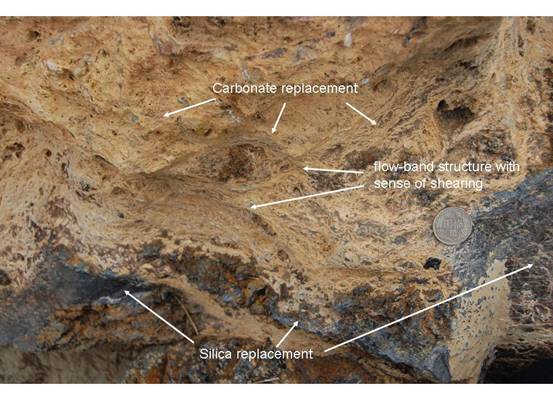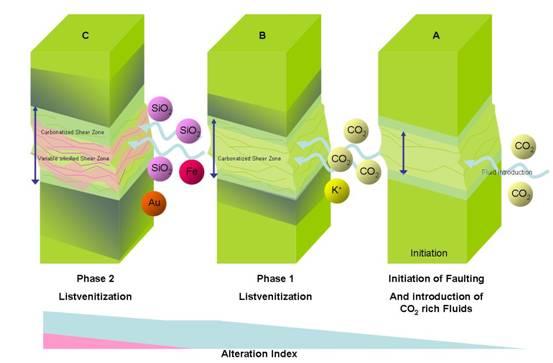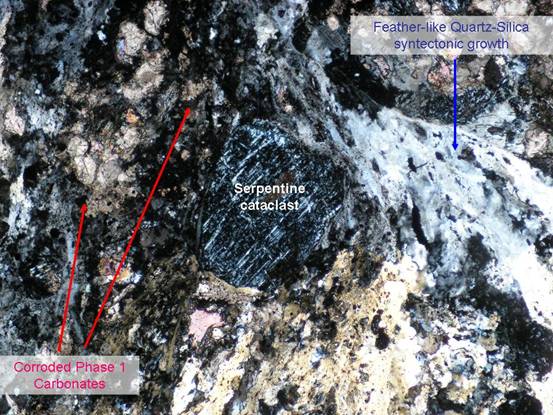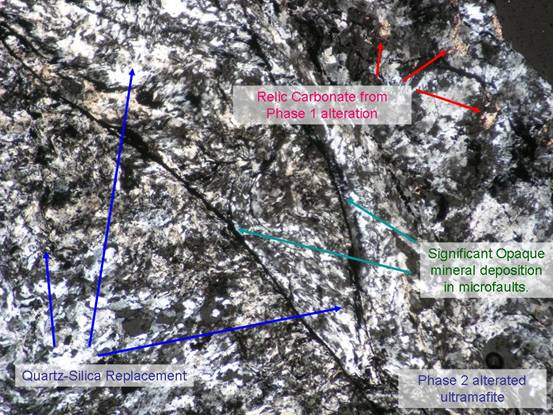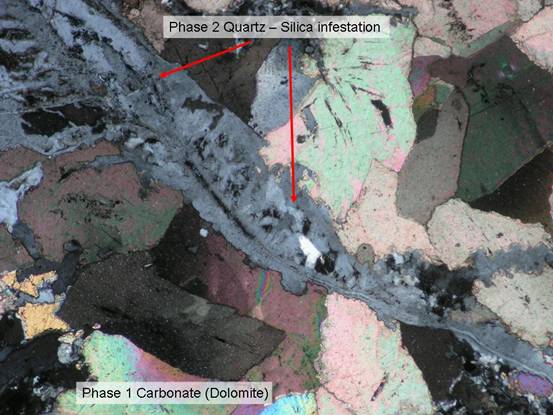臺灣北部金瓜石酸性礦山排水地區之溪水及
海水成分與硫酸氫氧氧化鐵沈澱作用之關係
Variations in Stream and Seawater Chemistry in Relation to Precipitation of Iron Oxyhydroxysulfates
in the Acid Mine Drainage Area, Chinkuashih, Northern Taiwan
酸性礦山排水(acid mine drainage; AMD)是由於廢礦石中黃鐵礦和白鐵礦等硫化鐵礦物之風化作用所間接造成,其pH值為2~4較一般河水酸,並富含大量的重金屬離子,因此其所造成之環境衝擊為目前極重要的一個國際性研究議題。台灣北部金瓜石礦區之黃金瀑布AMD與濂洞溪會流後入海,不僅在黃金瀑布及其流經之河床形成厚層之黃褐色沉澱物,也在入海口近岸地區產生大量之黃色懸浮物,顯然AMD與河水及AMD-河水混染水體與海水之間發生了強烈化學反應,而這些黃色或黃褐色物質之沉澱顯然也會對天然水體成分有所影響。目前的研究方向在於瞭解這些水體的成分及其沉澱物特性之變化,並探討此種沉澱作用對水體中涉及反應之幾種不同離子的影響。

Figure 1. 金瓜石著名景點黃金瀑布。酸性礦山排水經由空氣接觸或受微生物作用後
使其所含大量二價鐵離子快速氧化而產生沈澱,河床表面金黃色沈澱物主
要為三價鐵所組成的硫酸(氫氧)氧化鐵礦物與針鐵礦。

Figure 2. 金瓜石酸性礦山排水流入濂洞灣後在海水表面形成大量黃色懸浮物,與周
圍海水形成強烈對比,俗稱“陰陽海”現象。
Faulted Zone Related Metasomatic Ultramafites from Kenting Melange,
Hengchun Peninsula, Southern Taiwan.
Is it Ophicarbonate? Listvenite? or simply something else?
Through field studies, all allochtonous ultramafite from Kenting melange were found metasomatized into a specific carbonate + quartz assemblages. These rocks are found as grayish-blue, with strong, hard weathering resistant silicified parts, as blocks or river floats within the vicinity of melange (figure 2). The metasomatic mineral assemblages are found as syntectonic growth and showing strong shearing affinities as flow band like textures(figure 3), locally brecciated and cemented by later metasomatic minerals.
|
|
| Figure 1. Geographical location of Hengchun Peninsula and Kenting Melange. |
Figure 2. Typical Lowland topography of Kenting melange,
with allochtonous ophiolitic blocksatop argillace-
ous melange matrix in evident. |
|
|
Figure 3. Close up view of the metasomatized ultramafic
rock. Showing pervasive alteration associated
with tectonic features (shearing). |
|
Mineralogical and Petrographical studies on these ultramafites shows its Protolith are mostly peridotite, with most primary mineral alterated into serpentinite and the later metasomatic minerals. Evidences show these rock were subject to hydrothermal alteration with high ƒCO2 and low K+ . The reaction can be interpreted as:
Serpentinite + carbonic acid + silicic acid = magnesite + water + silica
Mg3Si2O5(OH)4 + 3H2CO3 (aq) + (n)H4SiO4 (aq) = 3MgCO3 + (5+2n)H2O + (2+n)SiO2
???
According to degree of metasomatism, the alteration can be classified into 2 phases. The earlier phase 1, carbonatization stage, and second stage as phase 2 silicified stage. Pervasive hydrothermal activities were more alkaline and reducing at the earlier alteration stage, and as alteration degree proceeds further, the fluid evolves to a more oxidized, and acidic regime, and hence deposition of silica phase 2 alteration (figure 5). Most of the primary mineral phases are completely destroyed during metasomatic alteration, except Cr-Spinel (figure 4), where most of them reside only with minor ferritchromite development around its edges.
???
|
|
Figure 4. Pervasive replacement of carbonate, with breccia-
ted Cr-Spinel residual within the metasomatic
ultramafite. 40x |
Figure 5. Progressive alteration with migration of related
elements and Ions towards the end product. |
Together with its micro-texture, faulted nature, with its close affinities to metasomatic mineralization, this phenomenon are more commonly discovered within confined zone of a major detachment fault within ophiolite nappe elsewhere in the world. Petrographical observation shows that these metasomatic ultramafite found in Kenting melange are not true listvenite reported elsewhere in the ophiolite melange, sine it lacks potassium alteration. In a strict sense, it can only be a listvenite related rock according to Zhao (1995).
This gives a possible outcome of that these metasomatic ultramafite in Kenting melange has suffered similar tectonic process before it was dismembered and emplaced into argillaceous matrix of the melange.
The Investigation of the Gas Hydrates Reserved
Area: the Study of Sediment Micro-Texture
In 21 century, the gas hydrate is the most significant energy resources occurred in the sea floor sediment. There are several potential gas-hydrates-reserved localities discovered in the southwest Taiwan straits. The occurrences of micro-/nano-scale minerals and clay crystallinity are useful indicators investigating this resource. Thereby, this research focuses on the sediment micro-texture, phyllosilicate crystallinity and mineral chemistry for clarifying the paragenesis of gas-hydrates-related minerals by utilizing the XRD, SEM and electron microprobe analysis.
Our current study revealed the characters of the carbonate nodules, micro-pyrite overgrowth and iron-bearing smectite are strongly related to the gas venting activity. These exclusive results gave us critical hints to determine the existence of gas hydrate. The prospective research dedicatedly looking into sediment micro-texture of the gas hydrate reserved areas are expected to help us realize the conditions of gas hydrate formation.
|
|
Figure 1. The XRD pattern of the carbonate nodule. |
Figure 2. The pyrite framboids filled in the foraminiferan. |





